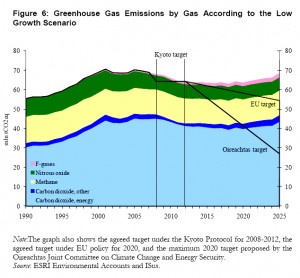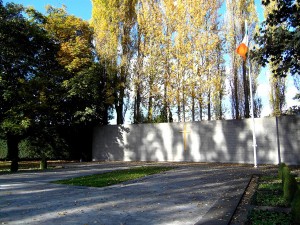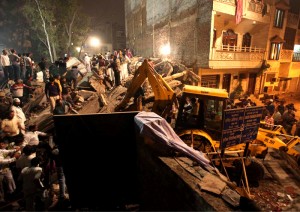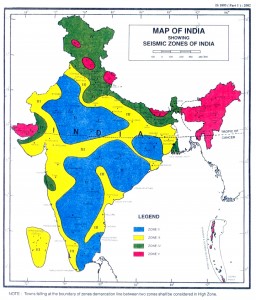2011-02-23: With the blanket media coverage of the upcoming Irish General Election, which will be held on Friday next, 25 February 2011 … the following 2 Environmental Protection Agency (EPA) Press Releases concerning the ongoing Kerdiffstown Landfill Fire Incident in County Kildare … which were issued in quick succession on Friday afternoon last, 18 February 2011 … may not have received adequate public attention …
1. Friday 18th February 2011: Statement on Behalf of Co-Ordinating Group
Re: Kerdiffstown Fire
Date released: Feb 18 2011, 3:12 PM
Active firefighting has been wound down as brigades undertake a phased withdrawal from the Kerdiffstown landfill site near Naas. The fire, which flared up on 18 January 2011, was unprecedented in Ireland and it proved very challenging. Initial assessments indicate that, by comparison with international experience, the time taken to suppress the fire was relatively short – given its nature and the environment in which it took place. Fire brigades will maintain a precautionary watch on the site until the middle of next week. The site remains a very dangerous area and people should not enter it for any reason. The Environmental Protection Agency has increased security in the interests of public safety and to prevent further trespass in the area.
And …
2. EPA to Develop Remediation Plan for Kerdiffstown Landfill, Naas, County Kildare.
Date released: Feb 18 2011, 3:26 PM
The EPA, HSE, Kildare County Council, Defence Forces and Gardaí have, for the past 27 days, been co-ordinating actions to deal with the fire and other environmental issues at Kerdiffstown Landfill, near Naas. In particular, the EPA has been working closely with Kildare Fire Service, providing expert advice in fighting the serious fire at the Kerdiffstown landfill site, contracting in providers of cold gas injection equipment and providing air monitoring and analysis. The EPA is exercising its powers under Section 56 of the Waste Management Act to secure the site and to start the longer-term process of remediation of the whole site. Already the EPA has begun the following preliminary works:
- removing stockpiles of fire-risk waste ;
- providing 24-hour security personnel at the site for the long-term ;
- establishing an on-site office ;
- increased on-site monitoring and inspection ;
- dealing with immediate Health & Safety issues on the site ;
- removing landfill leachate.
As the plan for the remediation progresses, the EPA will be meeting with the local community on a regular basis in order to hear their views and update them on the remediation project. Remediation works will be phased and the EPA will prioritise work that alleviates odour from the site in the short to medium term. Funding for the short-term emergency works to date has been provided by the Department of Environment, Heritage & Local Government. Further funding for the remediation will be released on a phased basis. The EPA has taken enforcement action against those involved in the operation of the Kerdiffstown site, including three High Court cases. High Court orders are in place preventing the deposit of any further waste onto the Kerdiffstown site. The EPA will use its powers under the Waste Management Acts to seek recovery of all costs expended by the State during the remediation project. The EPA is also seeking orders against directors of the companies who formerly operated the site in order to recover these costs. A criminal investigation file relating to the previous operations at the site has been submitted to the Director of Public Prosecutions.
A lot of words have been used in these press releases … but the amount of actual information which has been communicated to the public is Sweet FA ! And … please note well … there is no statement that the Landfill Fire has been extinguished.
.
PROTECTION OF FIREFIGHTERS & KERDIFFSTOWN LOCAL COMMUNITY
We consider that it is very important for Firefighters and Members of the Kerdiffstown Local Community, i.e. anybody who lives within 2 Km of the Landfill Site, to have sufficient information about Landfill Fires … in order to ask some pertinent questions about this fire incident.
I hate to say this … but, languishing on an important page of the FireOx International WebSite for many years … http://www.sustainable-design.ie/fire/proenv.htm … unloved (?!?) … has been this 2002 United States Report …
U.S. Fire Administration – Federal Emergency Management Agency
May 2002 / FA-225
LANDFILL FIRES – Their Magnitude, Characteristics, and Mitigation
Click the Link Above to read and/or download PDF File (583 kb)
.
As you read the document … pinch yourself hard, and try to remember that the Regulatory Control over Landfill Sites in Ireland has been LITE-LITE-LITE !!! … That there has been much illegal dumping all over the country !! … AND … That some Local Authorities have even forgotten where old, inactive Landfill Sites are located … a case I myself encountered in Clontarf, within the functional area of what was then known as Dublin Corporation !
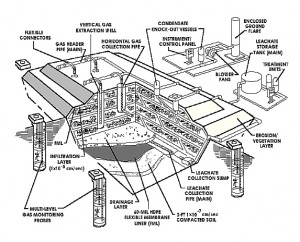
.
LANDFILL EMISSIONS – CLIMATE CHANGE & FIRE SAFETY ISSUES !
Extract from the 2002 U.S. Report … Page 8 …
Landfill emissions are the result of the decomposition of organic materials in the landfill (including yard waste, household waste, food waste, and paper). Because of the nature of the construction of landfills, this decomposition is anaerobic and results in the production of large quantities of Methane (which is highly flammable) and Carbon Dioxide. In fact, landfills are the largest source of methane emissions in the United States, accounting for 35% of methane emissions in 1999. MSW (municipal solid waste) landfills generate about 93% of U.S. landfill emissions; industrial landfills account for the remaining emissions. Methane emissions from landfills are affected by site-specific factors such as waste composition, available moisture, and landfill size. Approximately 28% of the methane generated in landfills in 1999 was recovered. The remainder of landfill-generated methane was dispersed in the air.
Approximately 50% of gas emitted from landfills is methane; carbon dioxide accounts for about 45 percent, and the remainder is composed of nitrogen, oxygen, hydrogen, and other gases. Both Methane and Carbon Dioxide are Greenhouse Gases (GHG’s) that pose environmental problems. Of the two gases, methane is far more potent than carbon dioxide.
[Media reports have also stated that Carbon Dioxide was used during attempts to suppress the Kerdiffstown Landfill Fire in County Kildare !?!]
.
HEALTH EFFECTS OF LANDFILL FIRES !
Extract from the 2002 U.S. Report … Pages 14 & 15 …
In addition to the burn and explosion hazards posed by landfill fires, smoke and other by-products of landfill fires also present a health risk to firefighters and others exposed to them. Smoke from landfill fires generally contains Particulate Matter (the products of incomplete combustion of the fuel source), which can aggravate pre-existing pulmonary conditions or cause respiratory distress. As with all fires, those in landfills produce toxic smoke and gases. The danger and level of toxicity of these gases depend on the length of exposure one has to them and on the type of material that is burning.
Underground fires can result in CO (Carbon Monoxide) levels in excess of 50,000 ppm (parts per million) – the Occupational Safety & Health Administration (OSHA) permissible exposure limit for CO is 50 ppm. OSHA standards prohibit worker exposure to more than 50 parts of the gas per million parts of air averaged during an 8-hour time period. Carbon Monoxide is harmful when breathed because it displaces oxygen in the blood and deprives the heart, brain, and other vital organs of oxygen, which can cause permanent damage or death.
Another serious concern in landfill fires is the emission of Dioxins. Accidental fires at landfills and the uncontrolled burning of residential waste are considered the largest sources of dioxin emissions in the United States. The term ‘dioxins’ refers to a group of chemical compounds with similar chemical and biological characteristics that are released into the air during the combustion process. Dioxins are also naturally occurring and are present throughout the environment. However, exposure to high levels of dioxins has been linked to cancer, liver damage, skin rashes, and reproductive and developmental disorders.
.
ENVIRONMENTAL IMPACT OF LANDFILL FIRES !
Extract from the 2002 U.S. Report … Pages 16 & 17 …
The smoke and run-off from landfill fires can be dangerous to those living in the area and to the environment. It is important that air and water quality issues be addressed early in a fire suppression operation to prevent contamination as much as possible. As mentioned earlier, water used to suppress a landfill fire can overwhelm a facility’s leachate collection system, if one exists (older facilities may have been constructed prior to regulations requiring leachate collection systems).
.
FIRE & LANDFILL CONTENTS !
Extract from the 2002 U.S. Report … Page 17 …
Fires occurring in landfills where hazardous wastes are buried can be particularly difficult. In past years, illegal dumping of hazardous and toxic materials in landfills and other dumping sites was relatively common. When a fire occurs and rescue workers have wrong or misleading information about the buried contents (e.g., illegal or unknown toxic or radioactive wastes), the fire suppression operation can be extremely dangerous.
Although not a landfill fire, the Wade Dump Fire in February 1978 clearly illustrates the dangers posed by fires involving unknown hazardous materials. Firefighters responded to a suspected tyre fire at an abandoned rubber shredding plant on the Delaware River outside of Philadelphia. They were unaware that the property’s owner and namesake, Melvin Wade, had transformed the plant into one of the most toxic hazardous waste dumpsites in U.S. history. By the night of the fire, more than 3 million gallons of cyanide, benzene, toluene, and other chemicals were stored on the site – plus thousands of junk tyres. The burning chemicals produced multi-coloured smoke and noxious fumes, which alerted firefighters to the unusual nature of the fire they were fighting. Intensified by chemicals and other fuels, the fire raged for hours. Drums of chemicals exploded, injuring firefighters and even damaging fire trucks. As the night progressed, firefighters and other emergency workers noticed that the chemicals were dissolving their protective gear and making it difficult for them to breathe; more than 40 firefighters were sent to a nearby hospital for treatment. Over the past 20 or more years, dozens of those who were present at the Wade Dump fire have become ill, and many have died from cancers and other diseases. Melvin Wade and others responsible for creating the toxic site were found criminally responsible for their actions.
.
JOINING SOME DOTS – CONTAMINATED PUBLIC WATER SUPPLIES IN IRELAND
On Thursday, 17 February 2011 … the Environmental Protection Agency (EPA) released the following report … with an accompanying, ‘spinned’ press release …
Environmental Protection Agency – Ireland
2011-02-17
The Provision & Quality of Drinking Water in Ireland – A Report for the Years 2008-2009
Click the Link Above to read and/or download PDF File (2.77 Mb)
.
Once again … pinch yourself hard, and try to remember that the Regulatory Control over Public Water Supplies in Ireland has been LITE-LITE-LITE !!! Our Public Water Supplies are not in good shape … to say the least. However, the management and control of the country’s landfill sites – legal, illegal and no longer known – IS a relevant and related issue to the contamination of our public water supplies … not the only issue.
Now, I don’t know about you … but I certainly am not happy about either the accuracy, or the reliability, of the recent EPA Report on Ireland’s Public Water Supplies !
.
.
END
